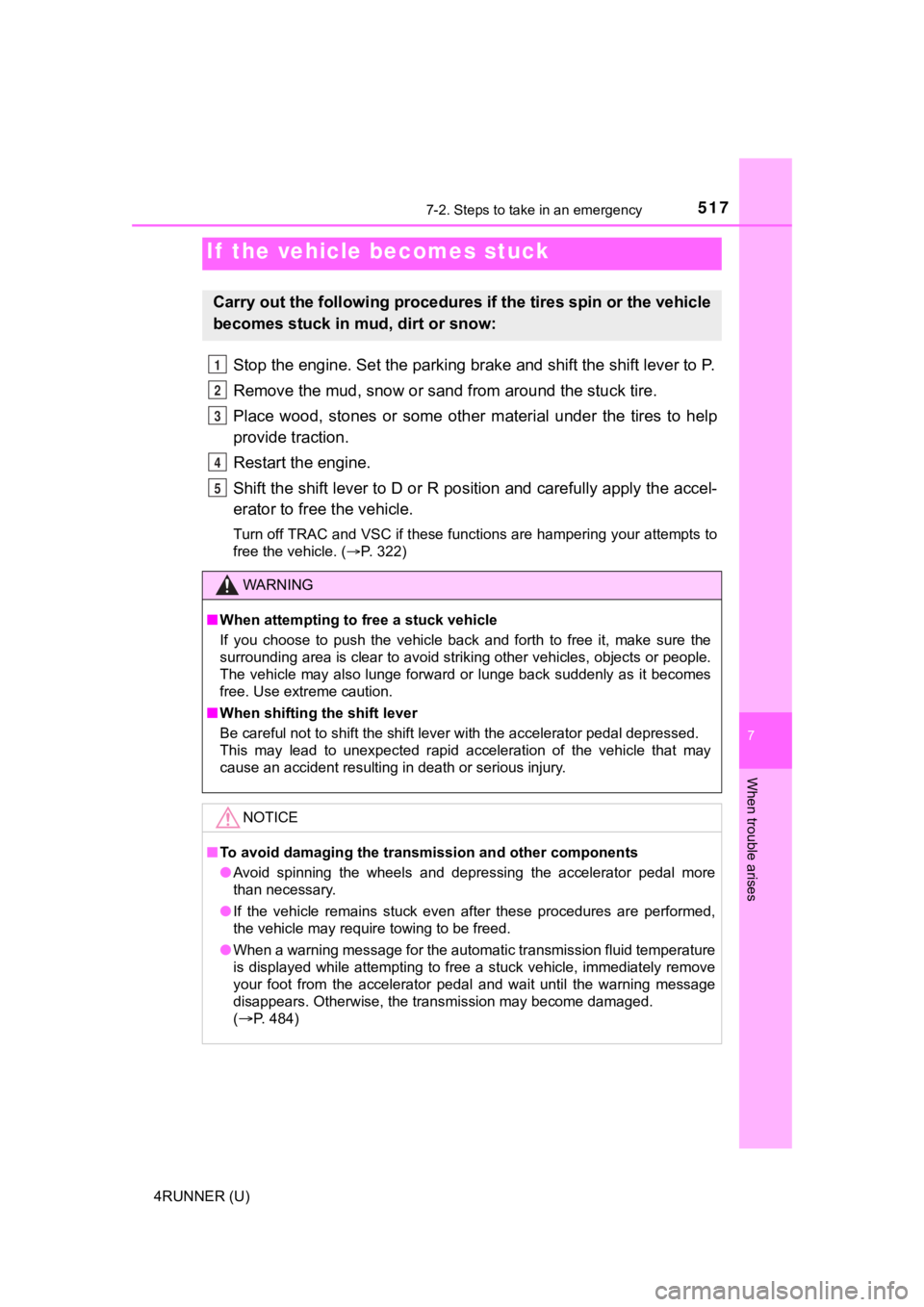2021 TOYOTA 4RUNNER parking brake
[x] Cancel search: parking brakePage 479 of 592

4797-2. Steps to take in an emergency
7
When trouble arises
4RUNNER (U)
*1: Parking brake engaged warning buzzer:A buzzer will sound if the vehicle is driven at a speed of appr oximately 3
mph (5 km/h) or more.
*2: Open door warning buzzer: The open door warning buzzer sounds to alert one or more of the doors is
not fully closed (with the vehicle having reached a speed of 3 mph [5 km/h]).
*3: Driver’s seat belt buzzer:
The driver's seat belt warning buzzer sounds to alert the drive r that his or
her seat belt is not fastened. Once the engine switch is turned to ON, the
buzzer sounds. If the seat belt is still unfastened, the buzzer sounds inter-
mittently for a certain period of time after the vehicle reache s a certain
speed.
Front passenger’s seat belt warning buzzer:
The front passenger’s seat belt warning buzzer sounds to alert the front
passenger that his or her seat belt is not fastened. If the sea t belt is unfas-
tened, the buzzer sounds intermittently for a certain period of time after the
vehicle reaches a certain speed.
*4: This light illuminates on the multi-information display.
■ SRS warning light
This warning light system monitors the airbag sensor assembly, front impact
sensors, side impact sensors (front door), side impact sensors (rear), safing
sensor (rear), driver's seat belt buckle switch, front passenger occupant clas-
sification system (ECU and sensors), “AIR BAG ON” and “AIR BAG OFF”
indicator lights, front passenger's seat belt buckle switch, se at belt preten-
sioners, airbags, interconnecting wiring and power sources. (P. 3 5 )
■ Key reminder buzzer (vehicles without a smart key system)
The buzzer indicates that the key has not been removed with the engine off
and the driver’s door opened.
■ Open moon roof reminder buzzer (if equipped)
The buzzer indicates that the moon roof is not fully closed with the engine off
and the driver’s door opened.
■ Front passenger detection senso r, passenger seat belt reminder and
warning buzzer
● If luggage is placed on the front passenger seat, the front pas senger detec-
tion sensor may cause the warning light to flash and the warnin g buzzer to
sound even if a passenger is not sitting in the seat.
● If a cushion is placed on the seat, the sensor may not detect a passenger,
and the warning light may not operate properly.
Page 489 of 592

4897-2. Steps to take in an emergency
7
When trouble arises
4RUNNER (U)
●Phillips screwdriver
● Stop the vehicle in a safe place on a hard, flat surface.
● Set the parking brake.
● Shift the shift lever to P.
● Stop the engine.
● Turn on the emergency flashers. ( P. 462)
If you have a flat tire
Your vehicle is equipped with a spare tire. The flat tire can b e
replaced with the spare tire.
For details about tires: P. 4 2 2
WARNING
■If you have a flat tire
Do not continue driving with a flat tire.
Driving even a short distance wit h a flat tire can damage the tire and the
wheel beyond repair, which cou ld result in an accident.
You will need the following item:
Before jacking up the vehicle
Page 505 of 592

5057-2. Steps to take in an emergency
7
When trouble arises
4RUNNER (U)
One of the following may be the cause of the problem:
● One or both of the battery t erminals may be disconnected.
● The battery may be discharged. ( P. 510)
● There may be a malfunction in the steering lock system (vehicles
with a smart key system).
Contact your Toyota dealer if the problem cannot be repaired, o r if repair
procedures are unknown.
When the engine does not start, the following steps can be used as an
interim measure to start the engine if the engine switch is fun ctioning
normally:
Set the parking brake.
Shift the shift lever to P.
Turn the engine switch to ACCESSORY mode.
Press and hold the engine switch for about 15 seconds while
depressing the brake pedal firmly.
Even if the engine can be start ed using the above steps, the sy stem
may be malfunctioning. Have the vehicle inspected by your Toyot a
dealer.
The starter motor does not turn over, the interior lights and h ead-
lights do not turn on, o r the horn does not sound.
Emergency start function (vehicles with a smart key system)
1
2
3
4
Page 517 of 592

5177-2. Steps to take in an emergency
7
When trouble arises
4RUNNER (U)
Stop the engine. Set the parking brake and shift the shift lever to P.
Remove the mud, snow or sand from around the stuck tire.
Place wood, stones or some other material under the tires to help
provide traction.
Restart the engine.
Shift the shift lever to D or R position and carefully apply th e accel-
erator to free the vehicle.
Turn off TRAC and VSC if these functions are hampering your att empts to
free the vehicle. ( P. 322)
If the vehicle becomes stuck
Carry out the following procedures if the tires spin or the vehicle
becomes stuck in mud, dirt or snow:
WARNING
■When attempting to f ree a stuck vehicle
If you choose to push the vehicle back and forth to free it, ma ke sure the
surrounding area is clear to avoid striking other vehicles, obj ects or people.
The vehicle may also lunge forward or lunge back suddenly as it becomes
free. Use extreme caution.
■ When shifting the shift lever
Be careful not to shift the shift lever with the accelerator pedal depressed.
This may lead to unexpected rapid acceleration of the vehicle t hat may
cause an accident resulting in death or serious injury.
NOTICE
■ To avoid damaging the transmission and other components
● Avoid spinning the wheels and depressing the accelerator pedal more
than necessary.
● If the vehicle remains stuck even after these procedures are pe rformed,
the vehicle may require towing to be freed.
● When a warning message for the automatic transmission fluid tem perature
is displayed while attempting to free a stuck vehicle, immediat ely remove
your foot from the accelerator pedal and wait until the warning message
disappears. Otherwise, the transmission may become damaged.
(
P. 484)
1
2
3
4
5
Page 527 of 592

5278-1. Specifications
8
Vehicle specifications
4RUNNER (U)
*: The fluid capacity is a reference quantity. If replacement is necessary, con-
tact your Toyota dealer.
*1: Minimum pedal clearance when depressed with a force of 110 lbf (490 N,
50 kgf) while the engine is running.
*2: Parking brake pedal travel when depressed with a force of 67 l bf (300 N,
30 kgf).
Automatic transmission
Fluid capacity*11.3 qt. (10.7 L, 9.4 Imp. qt.)
Fluid typeToyota Genuine ATF WS
NOTICE
■ Transmission fluid type
Using transmission fluid other than the above type may cause ab normal
noise or vibration, or damage the transmission of your vehicle.
Brakes
Pedal clearance*1
2WD models
3.36 in. (86 mm) Min.
4WD models
3.54 in. (90 mm) Min.
Pedal free playLess than 0.04 0.24 in. (1 6 mm)
Brake pad wear limit0.04 in. (1.0 mm)
Parking brake lining wear limit0.04 in. (1.0 mm)
Parking brake pedal travel*25 7 clicks
Fluid typeSAE J1703 or FMVSS No.116 DOT 3
Page 545 of 592

545
8
Vehicle specifications
4RUNNER (U)
8-2. Customization
When customizing vehicle features, ensure that the vehicle is parked
in a safe place with the shift le ver in P and the parking brake set.
■Changing by using the multi-information display
Use the meter control switches to select on the multi-infor-
mation display.
Choose the desired item usi ng or , and then press .
Select the desired setting by operating or , and then
press .
To stop the selection, press to return to the previous screen.
■
Changing on the audio system screen
Press the “MENU” button.
Select “Setup” on the “Menu” screen.
Select “General” or “Vehicle” on the “Setup” screen.
Various setting can be changed. Refer to the list of settings t hat can
be changed for details.
Customizable features
Your vehicle includes a variety of electronic features that can be
personalized to suit your preferences. The settings of these fe a-
tures can be changed by using the steering wheel switches, nav-
igation system, multimedia syste m or at your Toyota dealer.
It is also possible to customize certain vehicle features yours elf
using the multi-information display.
Customizing vehicle features
1
2
3
1
2
3
Page 577 of 592

577What to do if... (Troubleshooting)
4RUNNER (U)
●The seat belt reminder light is flashing
Are the driver and the front passenger wearing the seat belts?
(P. 477)
●The brake system warning light is on
Is the parking brake released? ( P. 224)
●The open door warning indicator is on
Are all the doors closed? (P. 110, 131)
Depending on the situation, other types of warning buzzer may a lso sound.
( P. 474, 484)
●Did anyone inside the vehicle open a door during setting the al arm?
The sensor detects it and the alarm sounds. ( P. 79)
To stop the alarm, turn the engine switch to IGNITION ON mode ( vehicles
with a smart key system) or start the engine.
●Is the electronic key left inside the vehicle?
Check the message on the multi-information display.
●When a warning light turns on, refer to P. 474.
●When a warning light turns on or a warning message or indicator is dis-
played, refer to P. 474, 484.
A warning buzzer sounds during driving
An alarm is activated and the horn sounds
A warning buzzer sounds w hen leaving the vehicle
(vehicles with a smart key system)
A warning light turns on or a warning message is displayed
Page 580 of 592

580Alphabetical index
4RUNNER (U)
Back doorBack door.............................. 131
Back window ......................... 166
Smart key system ................. 118
Wireless remote control ........ 110
Back window ............................ 166
Back-up lights Replacing light bulbs............. 457
Wattage ................................ 529
Battery ...................................... 417
Battery checking ................... 417
If the vehicle battery is discharged ...................... 510
Preparing and checking before winter....................... 329
Warning light ......................... 474
Bottle holders .......................... 366
Brake Fluid ...................................... 414
Parking brake........................ 224
Warning light ......................... 474
Brake assist ............................. 320
Brake override system ............ 177
Break-in tips ............................. 178
Brightness control Instrument panel light
control................................... 89 Care .................................. 392, 395
Exterior ................................. 392
Interior .................................. 395
Seat belts.............................. 396
Wheels and wheel ornaments .......................... 393
Cargo capacity......................... 191
Cargo hooks ............................ 367
Cargo net hooks ...................... 368
Center differential lock ........... 296
Chains ...................................... 331
Child restraint system............... 53 Booster seats, definition ......... 54
Booster seats, installation....... 65
Convertible seats, definition ... 54
Convertible seats,
installation ............................ 62
Front passenger occupant classification syst em ............ 46
Infant seats, definition............. 54
Infant seats, installation .......... 62
Installing CRS with LATCH anchors ............ 59
Installing CRS with seat belts...................................... 62
Installing CRS
with top tether strap.............. 66
BC